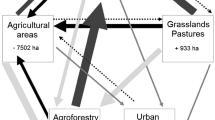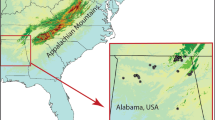Abstract
Pollution control initiatives in Greater Sudbury, Ontario, Canada, resulted in the decommissioning of the Coniston Smelter in 1972. The last assessment of the effects from the smelter on the surrounding lichen biota was in 1990, which showed an overall improvement in richness following these initiatives, but still few species were present close to the smelter. We examined five sites along this gradient to determine if this pattern is still present on the landscape. Sixty-four macrolichen species in 15 genera were found. Lichen richness and Shannon diversity increased at all sites, but the increase was no longer linear with distance from the smelter. There was no significant difference between lichen richness and diversity at sites at increasing distances from the smelter. We show that past air pollution from the Coniston Smelter is no longer restricting lichen growth and development in the Greater Sudbury area as it was historically. Lichen populations are, therefore, now shaped by other environmental variables.





Similar content being viewed by others
References
Anand M, Tucker BC, Desrochers R (2002) Ecological monitoring of terrestrial ecosystem recovery from man-made perturbation: assessing community complexity. 10th International Conference on Modelling Monitoring and Management of Air Pollution
Anand M, Ma KM, Okonski A, Levin S, McCreath D (2003) Characterizing biocomplexity and soil microbial dynamics along a smelter-damaged landscape gradient. Sci Total Environ 311:247–259
Armstrong RA (1987) Dispersal in a population of the lichen Hypogymnia physodes. Environ Exp Bot 27(3):357–363
Babin-Fenske J, Anand M (2010) Terrestrial insect communities and the restoration of an industrially perturbed landscape: assessing success and surrogacy. Restor Ecol 18:73–84
Babin-Fenske J, Anand M (2011) Patterns of insect communities along a stress gradient following decommissioning of a Cu-Ni smelter. Environ Pollut 159:3036–3043
Bates JW (1992) Influence of chemical and physical factors on Quercus and Fraxinus epiphytes at Loch Sunart, western Scotland: a multivariate analysis. J Ecol 80(1):163–179
Beckett PJ (1995) Lichens: sensitive indicators of improving air quality. In: Gunn JM (ed) Restoration and recovery of an industrial region. Springer, New York, pp 81–92
Brodo IM, Sharnoff SD, Sharnoff S (2001) Lichens of North America. Yale University Press, New Haven
Courtin GM (1994) The last 150 years: a history of environmental degradation in Sudbury. Sci Total Environ 148:99–102
Cristofolini F, Brunialti B, Giordani P, Nascimbene J, Cristofori A, Gottardini E, Frati L, Matos P, Batič F, Caporale S, Fornasier MF, Marmor L, Merinero S, Nuñez Zapata J, Tõrra T, Wolseley P, Ferretti M (2014) Towards the adoption of an international standard for biomonitoring with lichens—consistency of assessment performed by experts from six European countries. Ecol Indic 45:63–67
Culberson CF, Kristinsson H (1970) A standardized method for the identification of lichen products. J Chromatogr 46:85–93
Dreisinger BR, McGovern PC (1971) Sulphur dioxide levels and vegetation injury in the Sudbury area during the 1970 season. Department of energy and resources management. Air Management Branch, Sudbury
Esslinger TL (2012) A cumulative checklist for the lichen-forming, lichenicolous and allied fungi of the continental United States and Canada. North Dakota State University: http://www.ndsu.edu/pubweb/~esslinge/chcklst/chcklst7.htm (First Posted 1 December 1997, Most Recent Version (#18) 13 December 2012), Fargo, North Dakota
Geiser LH, Neitlich PN (2007) Air pollution and climate gradients in western Oregon and Washington indicated by epiphytic macrolichens. Environ Pollut 145(1):203–218
Gundermann DG, Hutchinson TC (1995) Changes in soil chemistry 20 years after the closure of a nickel–copper smelter near Sudbury, Ontario, Canada. J Geochem Explor 52:231–236
Gunn JM (1995) Restoration and recovery of an industrial region. Springer, New York
Gunn J, Keller W, Negusanti J, Potvin R, Beckett PJ, Winterhalder K (1995) Ecosystem recovery after emission reduction: Sudbury, Canada. Water Air Soil Pollut 85:1783–1788
Hale ME (1973) Growth. In: Ahmadjian V, Hale ME (eds) The lichens. Academic, New York
Hawksworth DL, Rose F (1970) Qualitative scale for estimating sulphur dioxide air pollution in England and Wales using epiphytic lichens. Nature 227:145–148
Hendershot WH, Lalande H, Duquette M (1993) Soil reaction and exchangeable acidity. In: Carter MR (ed) Soil sampling and analysis. Lewis Publishers, USA, pp 141–146
Henderson A (2000) Literature on air pollution and lichens XLIX. Lichenologist 32:89–102
Hutchinson TC, Symington MS (1997) Persistence of metal stress in a forested ecosystem near Sudbury, 66 years after closure of the O’Donnell roast bed. J Geochem Explor 58:323–330
Hutchinson TC, Whitby LM (1977) Effects of acid rainfall and heavy metal particulates on a boreal forest ecosystem near the Sudbury smelting region of Canada. Water Air Soil Pollut 7:421–438
Isocrono D, Matteucci E, Ferrarese A, Pensi E, Piervittori R (2007) Lichen colonization in the city of Turin (N Italy) based on current and historical data. Environ Pollut 145:258–265
Kricke R (2002) Measuring bark pH. In: Nimis PL, Scheidegger C, Wolseley PA (eds) Monitoring with lichens-monitoring lichens. Kluwer Academic Publishers in association with NATO Scientific Affairs Division, Netherlands, pp 333–336
Landis MS, Pancras JP, Graney JR, Stevens RK, Percy KE, Krupak S (2012) Receptor modeling of epiphytic lichens to elucidate the sources and spatial distribution of inorganic air pollution in the Athabasca oil sands region. In: Percy KE (ed) Developments in environmental sciences, vol 11, Alberta Oil Sands. Elsevier Ltd, Oxford, pp 427–467
Larsen RS, Bell JNB, James PW, Chimonides PJ, Rumsey FJ, Tremper A, Purvis OW (2007) Lichen and bryophyte distribution on oak in London in relation to air pollution and bark acidity. Environ Pollut 146:322–340
Leblanc F, Rao DN, Comeau G (1972) The epiphytic vegetation of Populus balsamifera and its significance as an air pollution indicator in Sudbury, Ontario. Can J Bot 50:519–528
McMullin RT, Lacey BW, Newmaster SG (2011) Estimating the biomass of woodland caribou forage lichens. Can J For Res 41:1961–1969
Mežka A, Brūmelis G, Piterāns A (2008) The distribution of epiphytic bryophyte and lichen species in relation to phorophyte characters in Latvian natural old-growth broad leaved forests. Folia Cryptogam Est 44:89–99
Nash TH (1973) Sensitivity of lichens to sulfur dioxide. Bryologist 76(3):333–339
Nash TH (2008) Lichen biology, 2nd edn. Cambridge University Press, New York
Nimis PL, Scheidegger C, Wolseley PA (eds) (2002) Monitoring with lichens-monitoring lichens. Kluwer Academic Publishers in association with NATO Scientific Affairs Division, Netherlands
Orange A, James PW, White FJ (2001) Microchemical methods for the identification of lichens. British Lichen Society, London
Potvin Air Management Consulting (2004) Air quality trends: City of Greater Sudbury, Ontario http://www.greatersudbury.ca/content/div_earthcare/documents/Air%20Quality%20Trends%20-%20June%2020041.pdf Accessed 1 November 2012
Potvin RR, Negusanti JJ (1995) Declining industrial emissions, improving air quality, and reduced damage to vegetation. In: Gunn JM (ed) Restoration and recovery of an industrial region. Springer, New York, pp 51–65
Robitaille J, Linley RD (2006) Structure of forests used by small mammals in the industrially damaged landscape of Sudbury, Ontario, Canada. For Ecol Manag 225:160–167
SARA group (2008) Historical review of air emissions from the smelting operations. In Volume1: Sudbury area risk assessment. 3–1 – 3–55 http://www.sudburysoilsstudy.com/EN/media/Volume_I/SSS_Vol_I_Chapter_3_HistoricalReviewofAirEmissions_FINAL%20_Jan2008.pdf Accessed 1 November 2012
Shannon CE (1948) A mathematical theory of communication. AT&T Tech J 27:379–423, and 623–656
Showman RE (1997) Lichen recolonization in the upper Ohio valley. Bryologist 100(4):478–481
Tomassini FD, Puckett KJ, Nieboer E, Richardson DHS, Grace B (1976) Determination of copper, iron, nickel and sulphur by X-ray fluorescence in lichens from the Mackenzie Valley, Northwest Territories, and the Sudbury District, Ontario. Can J Bot 54:1591–603
United States Forest Service (USFS). n.d. National lichens and air quality database and Clearinghouse. http://gis.nacse.org/lichenair/index.php?page=workgroup# Accessed 1 November 2012
Winterhalder K (1996) Environmental degradation and rehabilitation of the landscape around Sudbury, a major mining and smelting area. Environ Rev 4:185–224
Acknowledgments
We gratefully acknowledge the National Sciences and Engineering Research Council of Canada for funding (Discovery grant to M.A.), Cara Bulger and Arundhati Das for assistance with fieldwork, the private landowners of Raft Lake that allowed us access to their property, and Steven Newmaster and the Biodiversity Institute of Ontario Herbarium for in-kind support.
Author information
Authors and Affiliations
Corresponding author
Additional information
Responsible editor: Philippe Garrigues
Rights and permissions
About this article
Cite this article
Schram, L.J., Wagner, C., McMullin, R.T. et al. Lichen communities along a pollution gradient 40 years after decommissioning of a Cu-Ni smelter. Environ Sci Pollut Res 22, 9323–9331 (2015). https://doi.org/10.1007/s11356-015-4088-4
Received:
Accepted:
Published:
Issue Date:
DOI: https://doi.org/10.1007/s11356-015-4088-4




